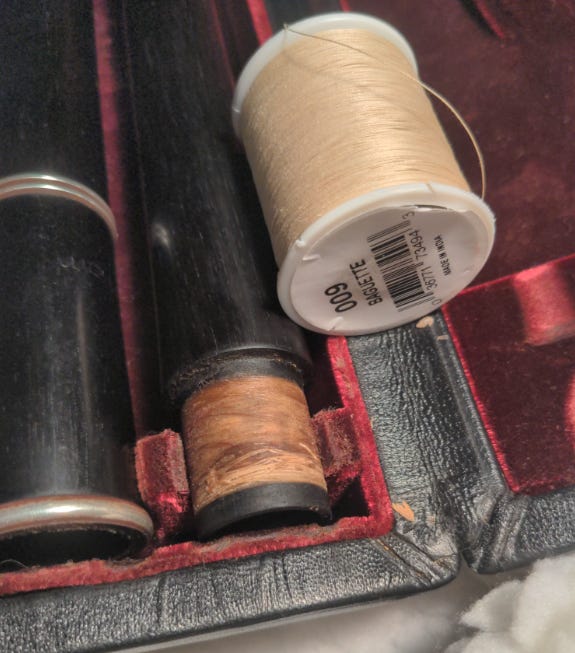The parts of a flute must fit tight, otherwise all sorts of nasty sounds emit. When the cork wears out, what do you do? What would Mozart do?
My favorite flute is the Patrick Olwell D. One of the last he made before his son took over the business. Patrick O. became world renown. He made innovations that were somehow not known about in the past. A rare case where a new craftsman went beyond his predecessors. All Irish flute players know about Patrick Olwell.
The different sections of the flute need to fit tightly together. This is usually achieved by putting a thin layer of cork on one end, which fits snugly into the other piece. When the cork wears out you need to fix that. I tried several times. Buying cork strips is a challenge. For some reason the thicknesses I get from the music supply companies are never right. I try sanding down a too think piece. I try putting two thin layers on top of each other. But tonight, nothing is working.
OK. Go to the toolbox, get the Swagelock PTFE tape (seen above in the white plastic rings.) Used for sealing vacuum connections. Or, in others words, plumber tape. Wrap that around the connection section, and…!?!?!? are we all GOOD? Mozart, you listening?
This lasts me a about a month. I make it through two performances, but each time the plastic is bunching up more and more. And the aesthetics suck. I start hiding the flute from… no one really… but we need a different solution.
Time to try the thread method. This is clearly a “poor man’s” solution, because not all of us can afford expensive cork, but most everyone has some thread.
I went to a fabric store. Two isles of threads. But they are all polyester. Does no one make cotton thread anymore? Finally, on the end cap of the isle, clearly the “odds & ends” section, I find a plain cotton, not dyed, calls itself “quilting thread.”
The first try goes wrong, as first tries often do. I do not have the patience or muscle knowledge to wind it evenly, so the end result is wavy, bunched. Take it all off, try again, this time intentionally SLOWING DOWN AND RELAXING. The end result is good - good enough. When I put on the cork wax, which is now thread wax, that kind of smooths together with the threads, creating a more solid surface.
Several performances go by, and this is working just fine. There is a bit of a wiggle between the two pieces, though I don’t think the sound is suffering. I try putting on a few more windings on the side that seems to me needs a little more thickness. You can see it in the photograph, the lighter portion at the end.
I am tickled pink with the whole process - and am now a full convert to the thread method.



Hi Mike,
How about a thinly-wound silicone strip in lieu of the plumber's tape? Or even a suitably thick short-segment silicone tube? It'll compress and re-expand repeatedly I'd imagine.
That is pipe tape. Plumber’s tape is pliable metal strap with regularly spaced holes in it to secure pipes to structural members.